Table of Contents
- Introduction
- Editor’s Choice
- Global Mushroom Market Overview
- Nutritional Facts About Mushrooms
- Global Mushroom Production Statistics
- Mushroom Export Statistics
- Mushroom Import Statistics
- Mushroom Cost Statistics
- Customer Preferences in Buying of Mushrooms Statistics
- Mushroom Production and Processing Challenges Statistics
- Recent Developments
- Conclusion
- FAQs
Introduction
Mushroom Statistics: Mushrooms, separate from both plants and animals, are cultivated through precise methods like substrate-based growth and controlled environmental conditions. Varieties such as button, shiitake, and oyster mushrooms boast distinctive flavors.
They are renowned for their nutritional value, being packed with vitamins and minerals while remaining low in calories and fat.
The global mushroom market is on the rise due to increasing consumer awareness and the perceived health benefits of mushrooms.
Challenges include the susceptibility to diseases, but there are prospects in the organic and specialty mushroom sectors and sustainable cultivation practices.
Consumers are gravitating toward organic and exotic mushroom choices. To sum it up, mushrooms are a varied and nourishing food source with a promising future in the market.
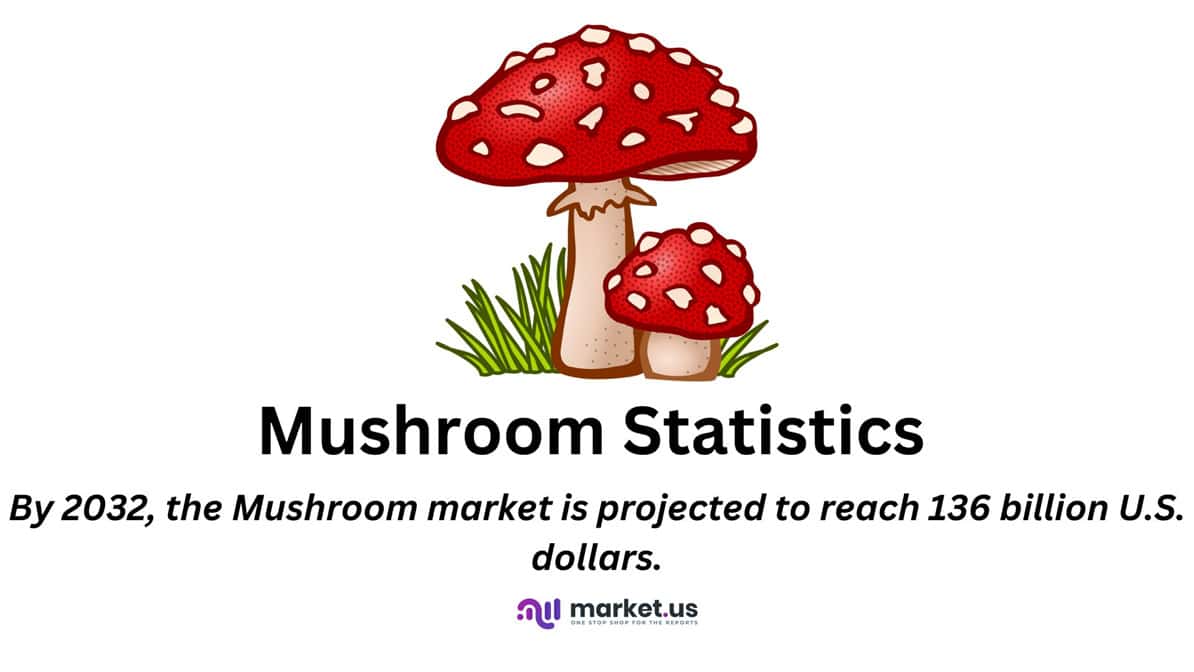
Editor’s Choice
- In 2023, the global mushroom market was valued at 62 billion USD.
- The food industry claims the largest share, commanding 42% of the market. Highlighting the significant presence of mushrooms in culinary applications worldwide.
- In a typical serving, which is about to provide 15 calories, mushrooms are remarkably low in fat, containing only 0.2 grams.
- Global mushroom production started at 0.17 MT in 1960 and reached 34.8 MT by 2013, and it is believed to have exceeded 40 MT currently.
- In the global landscape of mushroom and truffle production. Mainland China emerges as the undisputed leader, contributing a staggering 41,117.74 thousand metric tons to this thriving industry.
- According to Volza’s Global Export data, worldwide shipments of dried mushrooms reached 147.8K units, with contributions from 2,594 exporters serving 4,212 buyers.
- In the global market for fresh or chilled mushrooms. Poland emerges as a prominent player with a substantial export value of USD 492.56 million.
- In May 2022, the cost per ton of mushrooms stood at $4,471 (CIF, US), marking a 4.4% decrease compared to the previous month.

Global Mushroom Market Overview
Global Mushroom Market Size Statistics
- The global mushroom market has exhibited a steady upward trajectory in recent years at a CAGR of 9.5%, as evidenced by the data representing its growth in terms of USD billion.
- In 2022, the market was valued at 56 billion USD, which increased to 62 billion USD in 2023.
- The subsequent years continued to witness positive growth, with projections indicating that the market will reach 67 billion USD in 2024 and further escalate to 75 billion USD in 2025.
- Looking ahead, the market is expected to maintain this upward momentum. With estimations pointing towards a value of 83 billion USD in 2026, 89 billion USD in 2027, and 95 billion USD in 2028.
- As we move into the next decade, the mushroom market is anticipated to cross the 100 billion USD threshold. With forecasts indicating a value of 104 billion USD in 2029 and 112 billion USD in 2030.
- The growth is projected to continue, with the market set to reach 123 billion USD in 2031 and an impressive 136 billion USD in 2032.
- This consistent growth trajectory underscores the promising potential and resilience of the global mushroom market.
(Source: Market.us)
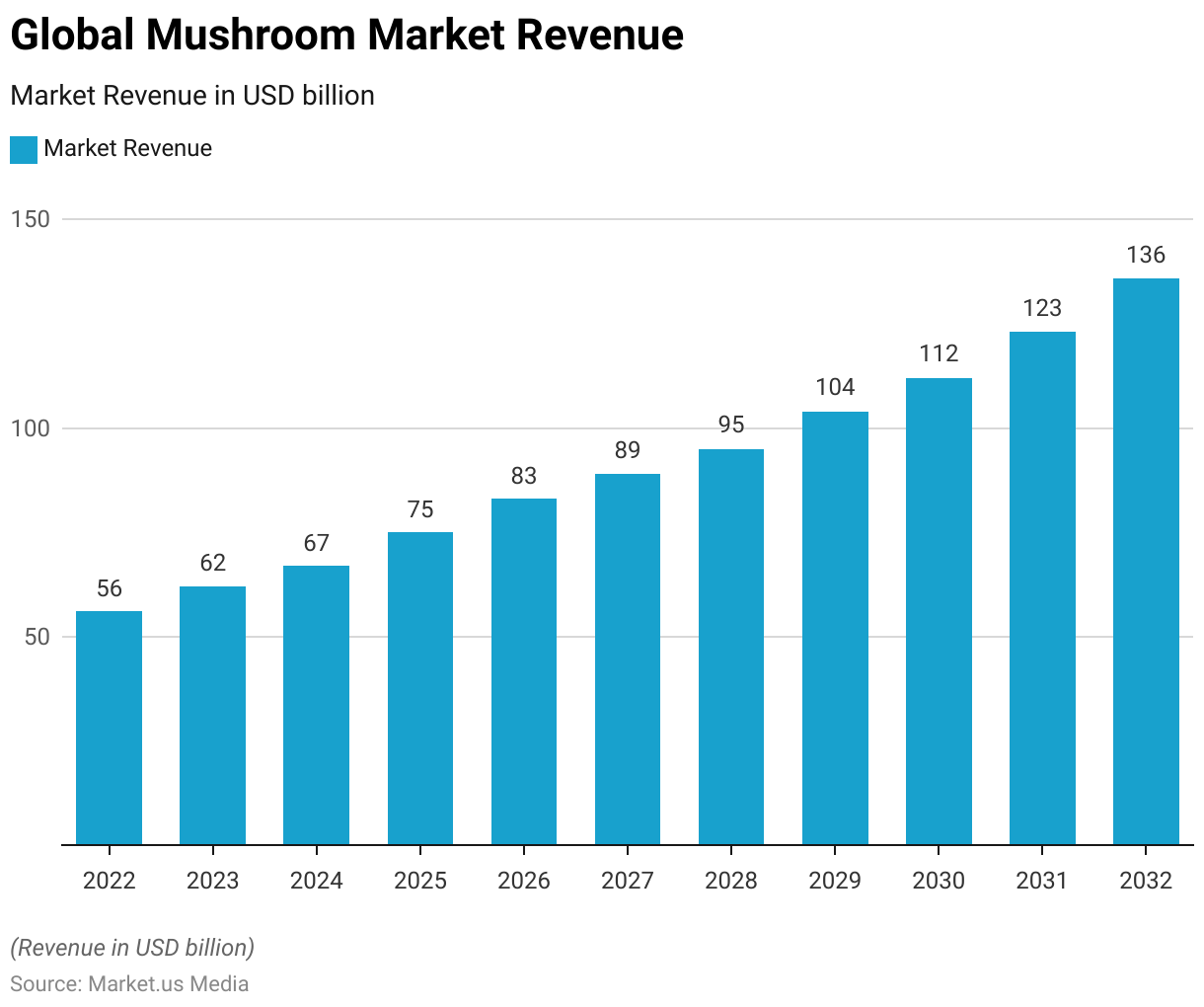
Global Mushroom Market Size – By Type Statistics
- The global mushroom market, segmented by various types including Button, Oyster, Shiitake, and other varieties, has shown consistent growth in terms of revenue in recent years.
- In 2022, the total market revenue was recorded at 56 billion USD, with Button Mushrooms contributing 22 billion USD. Oyster mushrooms are 17 billion USD, Shiitake mushrooms 10 billion USD, and other types account for 7 billion USD.
- The subsequent years continued to demonstrate positive trends, with 2023 witnessing a total market revenue of 62 billion USD. Comprising 24 billion USD from Button mushrooms, 19 billion USD from Oyster mushrooms, 11 billion USD from Shiitake mushrooms, and 8 billion USD from other types.
- As we progress to 2024, the market is projected to grow further, reaching 67 billion USD in total revenue. Button, Oyster, Shiitake, and other mushrooms contributed 26 billion USD, 20 billion USD, 12 billion USD, and 8 billion USD, respectively.
- This growth trend is expected to persist, with the market forecasted to achieve a total revenue of 136 billion USD in 2032. Reflecting the resilient and promising nature of the global mushroom industry across its various segments.
(Source: Market.us)

Global Mushroom Market Share – by End-User
- The global mushroom market exhibits a diverse distribution of market share across different end-use industries.
- In this breakdown, the food industry claims the largest share, commanding 42% of the market, highlighting the significant presence of mushrooms in culinary applications worldwide.
- Following closely is the pharmaceutical sector, which holds a substantial 34% share. Showcasing the growing importance of mushrooms in the development of pharmaceutical products and medicines.
- Additionally, the cosmetics industry also plays a notable role, accounting for 24% of the market share, indicating the utilization of mushrooms in skincare and beauty products.
- This distribution underscores the versatility of mushrooms and their wide-ranging impact across various sectors. Making them a valuable and multifaceted commodity in the global market.
(Source: Market.us)
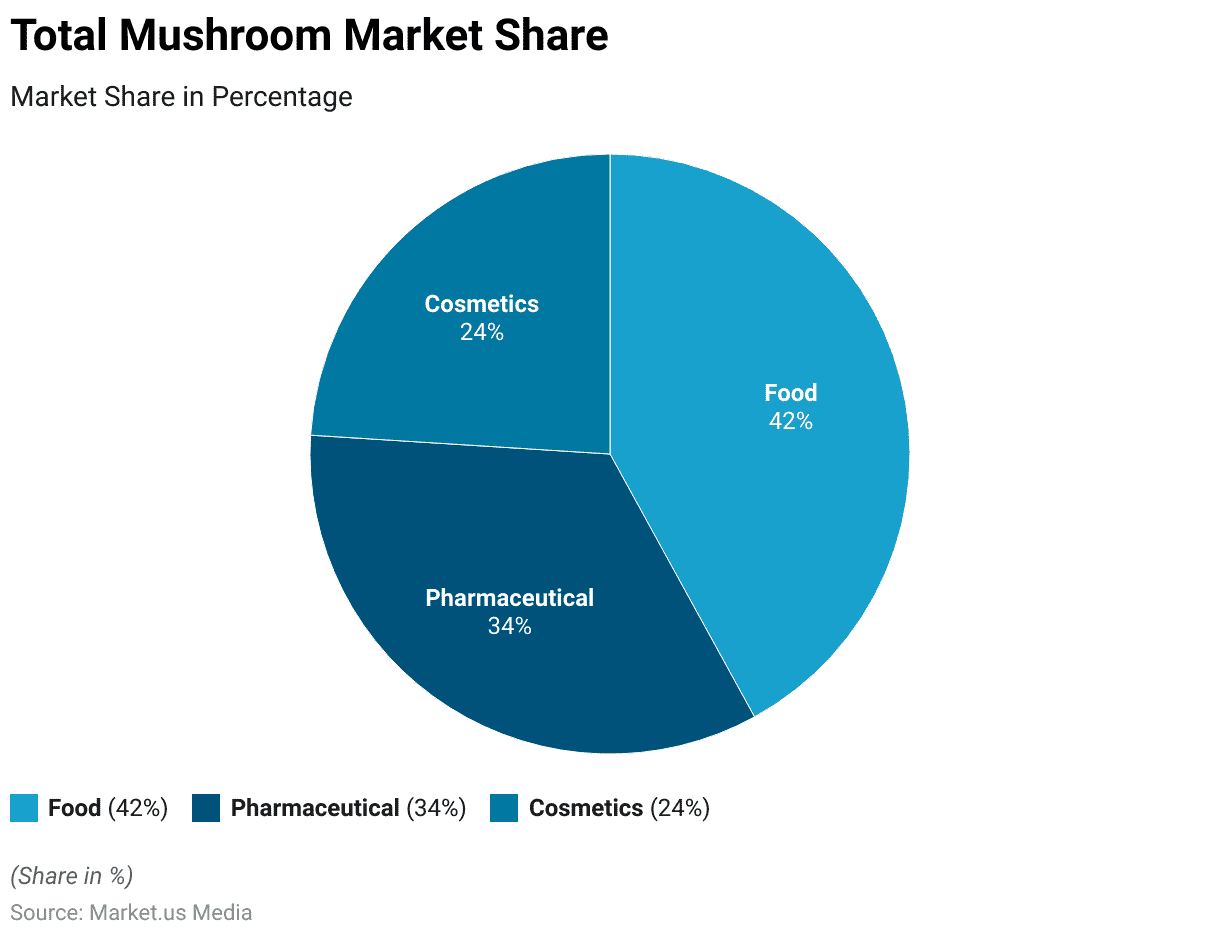
Nutritional Facts About Mushrooms
- Mushrooms, often enjoyed as a culinary delight, offer a nutrition profile that combines both flavor and health benefits.
- In a typical serving, which is about to provide 15 calories, mushrooms are remarkably low in fat, containing only 0.2 grams.
- Their sodium content is relatively minimal, measuring at 3.5 milligrams. Making them a suitable choice for those watching their salt intake.
- On the carbohydrate front, mushrooms contribute 2.3 grams. With a notable portion of that comprising dietary fiber, standing at 0.7 grams.
- Additionally, mushrooms contain 1.4 grams of sugar and provide a source of protein, boasting 2.2 grams per serving.
- These nutritional attributes make mushrooms a wholesome and low-calorie addition to various dishes, appealing to both taste and dietary considerations.
(Source: U.S. Department of Agriculture)
Global Mushroom Production Statistics
- According to FAOSTAT data, mushroom production grew from 0.5 million tonnes (MT) in 1961 to 10.24 MT in 2017.
- Global mushroom production started at 0.17 MT in 1960 and reached 34.8 MT by 2013, and it is believed to have exceeded 40 MT currently.
(Source: FAOSTAT)
Mushroom Production According to Continent
- The global distribution of mushroom production reveals a compelling breakdown across continents.
- Asia takes the forefront in this dynamic industry, commanding a substantial 82.8% share, underscoring its dominance in the cultivation of mushrooms.
- In contrast, Europe contributes 12% of the global production, positioning itself as a significant player in the market.
- Oceania and Africa make more modest contributions, accounting for 0.4% and 0.3% of the total production, respectively.
- The Americas, encompassing North, Central, and South America, collectively make up 4.5% of the global mushroom production landscape.
- This data highlights the substantial presence of Asia in mushroom cultivation, while also acknowledging the noteworthy contributions from Europe and the Americas. Albeit on a smaller scale, in this thriving global industry.
(Source: FAOSTAT)
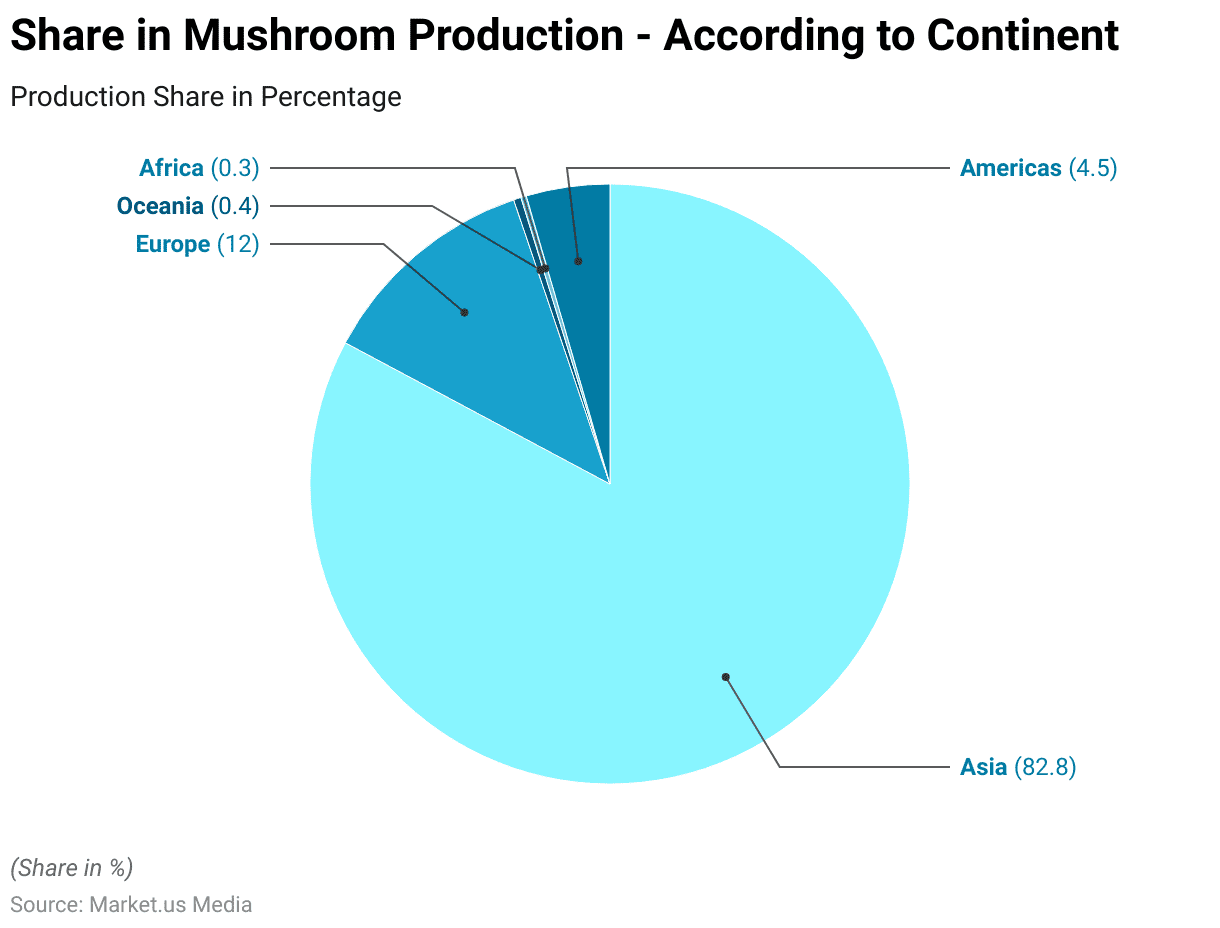
Leading Mushroom and Truffle-Producing Nations
- In the global landscape of mushroom and truffle production, Mainland China emerges as the undisputed leader, contributing a staggering 41,117.74 thousand metric tons to this thriving industry.
- Following at a considerable distance, Japan stands as a notable player with a production output of 469.05 thousand metric tons, showcasing its significance in the market.
- Poland, with its robust agricultural sector, secures the third position with a production volume of 387.8 thousand metric tons, highlighting its role as a major contributor.
- The United States and the Netherlands follow closely, producing 343.82 and 260 thousand metric tons, respectively.
- India and Spain further bolster the global production landscape with 243 and 163.8 thousand metric tons, respectively.
- Canada and the Russian Federation contribute significantly with 137.8 and 110.98 thousand metric tons, respectively.
- Lastly, France, with a production output of 99.11 thousand metric tons, adds its unique flair to the diverse global market for mushrooms and truffles.
- This data underscores Mainland China’s dominant position while also acknowledging the significant contributions of various other nations in this thriving industry.
(Source: Statista)
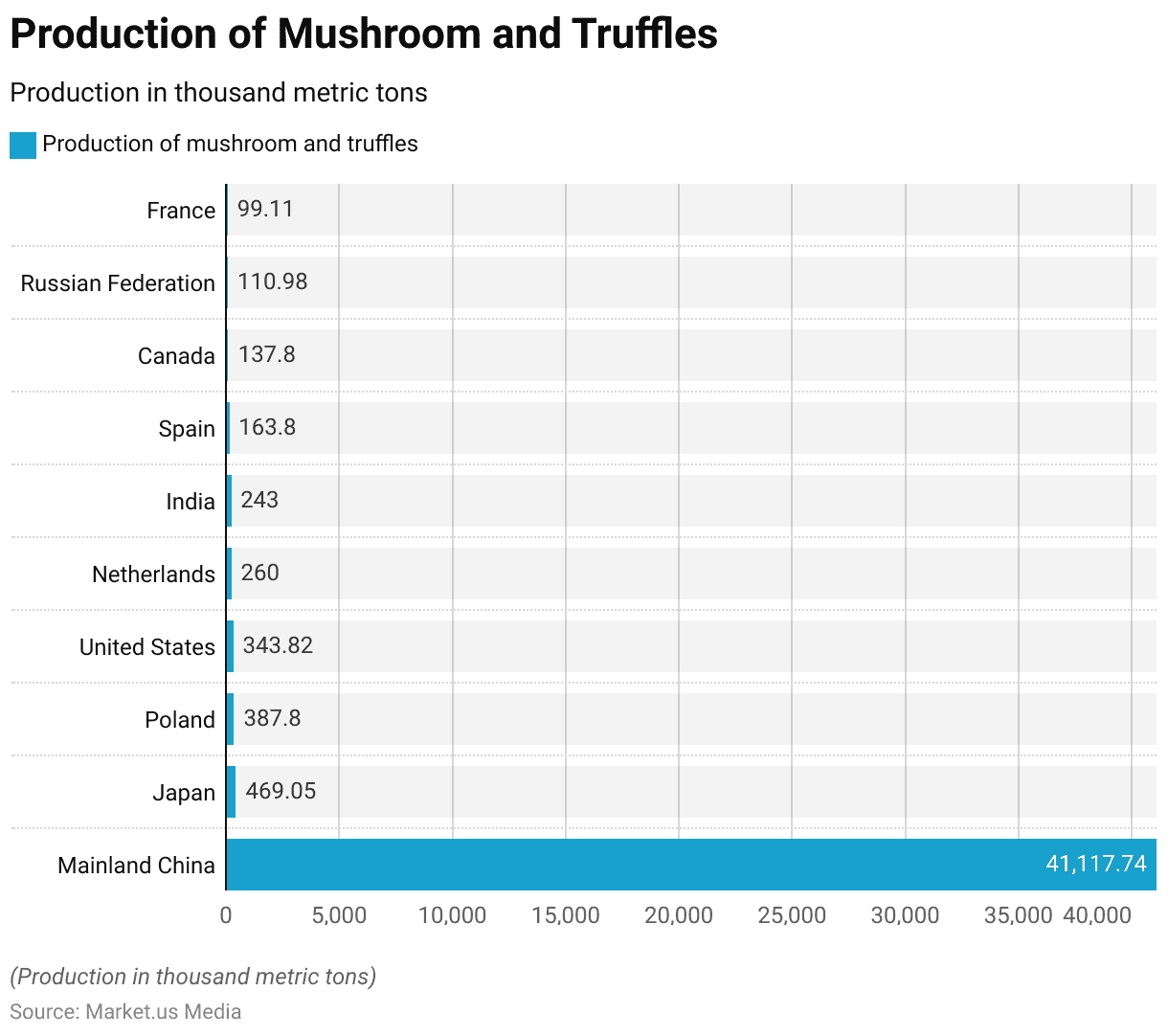
Mushroom Export Statistics
- According to Volza’s Global Export data, worldwide shipments of dried mushrooms reached 147.8K units, with contributions from 2,594 exporters serving 4,212 buyers.
- The primary destinations for global dried mushroom exports are the Netherlands, the United States, and Germany.
- Germany leads as the largest exporter with 13,657 shipments, followed closely by China with 13,187, and the Netherlands securing the third position with 12,061 shipments.
(Source: Volza)
Key Mushroom Exporting Nations
- In the global market for fresh or chilled mushrooms, Poland emerges as a prominent player with a substantial export value of USD 492.56 million.
- Following closely behind is Canada, contributing significantly to the industry with exports valued at USD 323.39 million.
- The Netherlands and Ireland also make notable contributions, with export values of USD 161.82 million and USD 111.4 million, respectively.
- While China, Mexico, and Belgium exhibit relatively lower export values at USD 35.26 million, USD 29.2 million, and USD 28.8 million, they remain active participants in this market.
- In contrast, the United States and the United Kingdom demonstrate comparatively modest export values of USD 23.03 million and USD 21.66 million. While Lithuania rounds out the list with exports valued at USD 20.31 million.
- These figures collectively reflect the dynamics of the global fresh or chilled mushroom export industry. Poland and Canada leading the way in terms of export value. While other countries also play essential roles in this thriving market segment.
(Source: Statista)

Mushroom Import Statistics
- In May 2022, Canada emerged as the primary supplier of mushrooms and truffles to the United States, contributing 6,000 tons, which accounted for a substantial 76% of total imports.
- Notably, Canada’s mushroom and truffle imports to the United States were five times greater than those from Mexico, the second-largest supplier, which provided 1,300 tons.
- China secured the third position, with 350 tons, representing a 4.4% share.
- Throughout the period from January 2022 to May 2022, Canada demonstrated steady, albeit modest, monthly growth in volume.
- Conversely, Mexico and China experienced monthly declines of -3.3% and -22.4%, respectively.
- In terms of value, Canada held a dominant position, with a contribution of $29 million, making up 81% of the total mushroom and truffle imports to the United States.
- Mexico followed as the second-largest supplier, with $4.8 million, accounting for 14% of total imports. South Korea came in third place with a 2.1% share.
- During the same January 2022 to May 2022 period, Canada exhibited steady but moderate monthly growth in value.
- In contrast, Mexico and South Korea saw monthly declines of –1.7% and -3.5%, respectively.
(Source: IndexBox)
Mushroom Cost Statistics
- In May 2022, the cost per ton of mushrooms stood at $4,471 (CIF, US), marking a 4.4% decrease compared to the previous month.
- Throughout this period, the import prices remained relatively stable, with the most significant increase occurring in March 2022, when the average import price rose by 5.7% month-on-month, reaching a peak of $4,747 per ton.
- However, from April 2022 to May 2022, import prices showed limited growth. Notably, prices varied significantly depending on the country of origin, with Canada having the highest price at $4,769 per ton, while China offered one of the lowest prices at $1,305 per ton.
- From January 2022 to May 2022, Mexico experienced the most substantial price growth, with an increase of 1.7%, while other major suppliers saw mixed price trends.
(Source: IndexBox)
Customer Preferences in Buying of Mushrooms Statistics
According to Gender Statistics
- Customer preferences for purchasing mushrooms are influenced by gender, with a noticeable disparity in percentages.
- Among mushroom buyers, 60% are male, while the remaining 40% are female.
- This data indicates that there is a higher proportion of male consumers who prefer mushrooms compared to their female counterparts.
- Understanding these gender-based preferences can be valuable for businesses and marketers in tailoring their marketing strategies and product offerings to effectively target their respective customer segments.
(Source: Eurchembull)
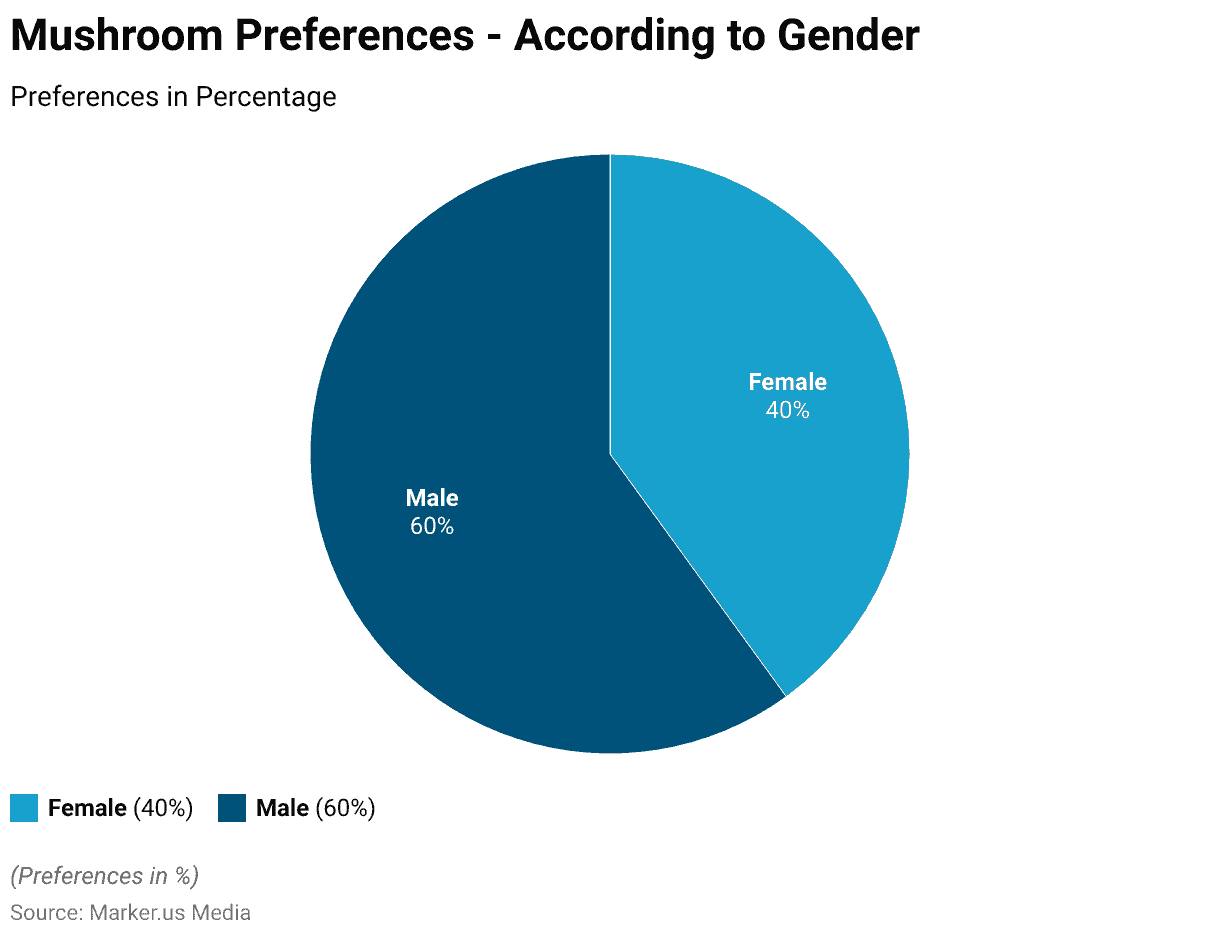
According to Age Group Statistics
- Customer preferences for purchasing mushrooms exhibit variations across different age groups.
- The data reveals that the 18-24 age group constitutes the largest segment of mushroom buyers, comprising 41.3% of the total.
- Following closely behind, the 25-34 age group accounts for 33.8% of mushroom consumers. In contrast, the 35-44, 45-54, and 55 and above age groups represent smaller percentages of 13.1%, 6.3%, and 5.6%, respectively.
- These statistics highlight that younger age groups, particularly those between 18 and 34, show a stronger preference for mushrooms, while older age groups exhibit comparatively lower levels of interest in mushroom consumption.
- Understanding these age-based preferences can inform marketing strategies aimed at catering to specific demographic segments.
(Source: Eurchembull)
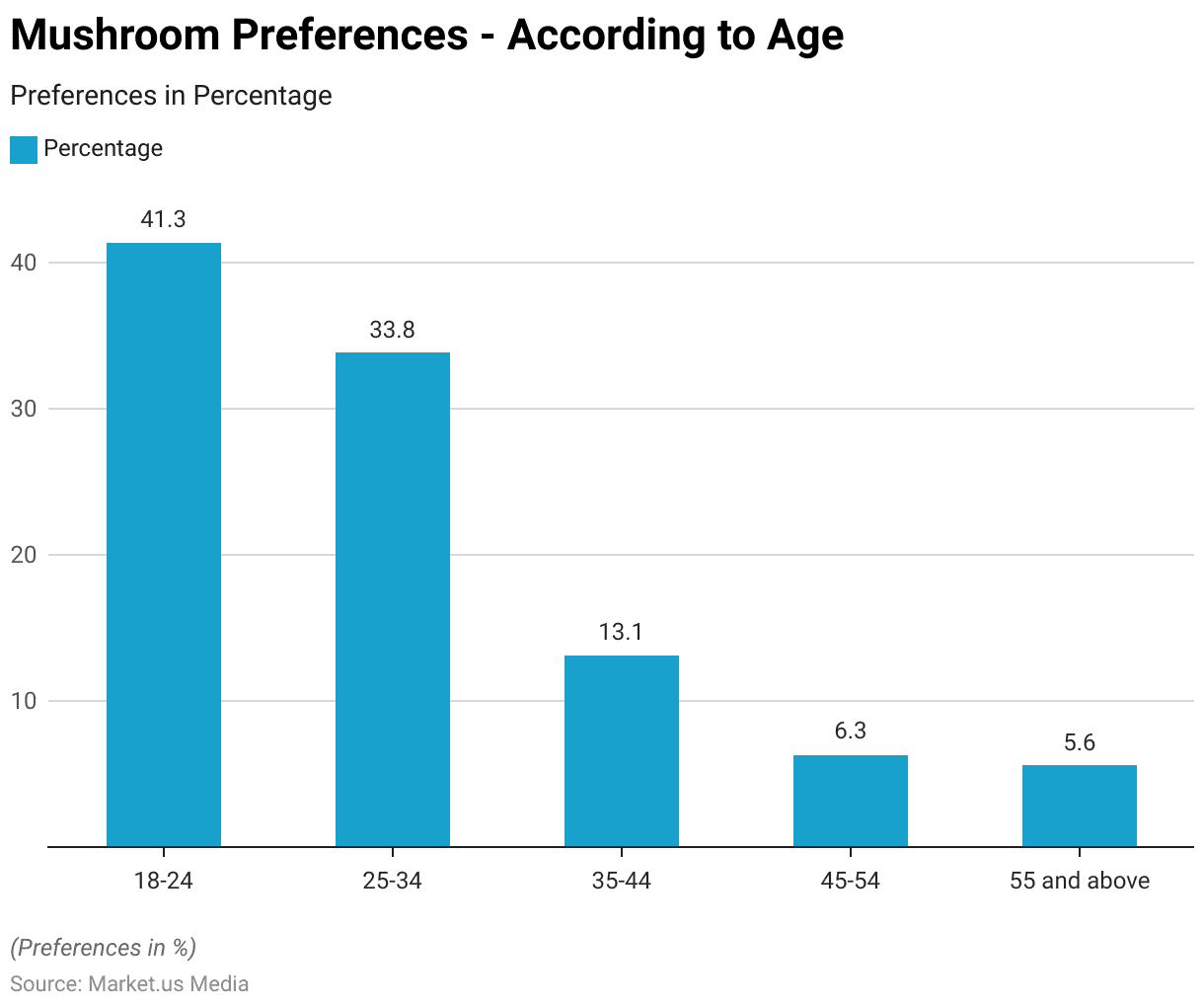
According to Mushroom Varieties Statistics
- Customer preferences in mushroom purchases vary significantly depending on the type of mushroom.
- The data indicates that the majority of consumers, constituting 68.8%, prefer button mushrooms.
- Oyster mushrooms also garner a substantial portion of the market, with 23.1% of buyers favoring this variety.
- The remaining 8.1% of customers have a preference for other mushroom types.
- This information underscores the popularity of button mushrooms among consumers, followed by a notable demand for oyster mushrooms.
- Understanding these preferences for specific mushroom varieties is essential for businesses and suppliers to tailor their product offerings and meet the diverse needs of their customers effectively.
(Source: Eurchembull)
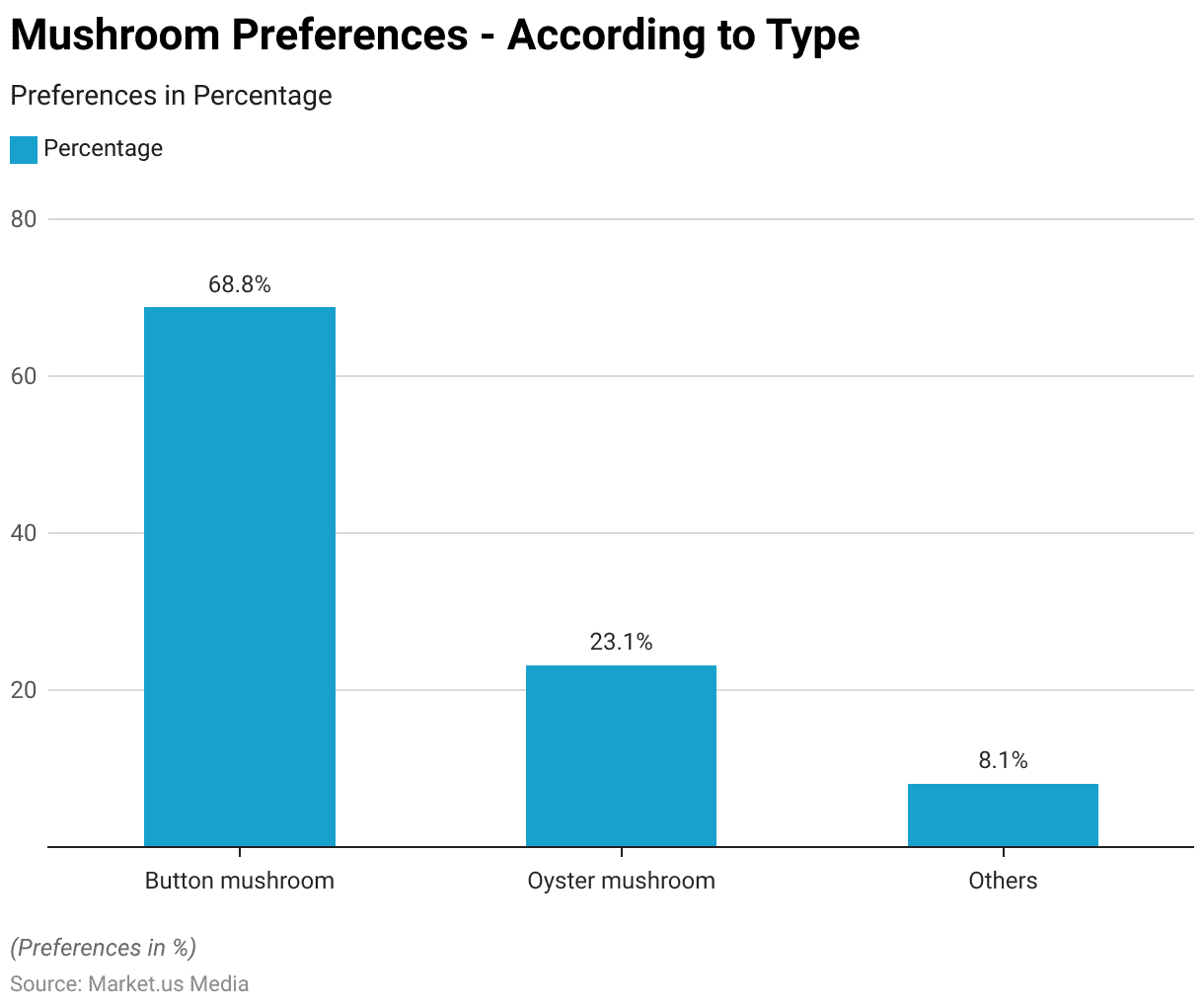
Mushroom Production and Processing Challenges Statistics
- A substantial majority, comprising 82%, had not been informed about the utilization of gamma irradiation for sterilizing mushroom compost.
- The remaining 18% were knowledgeable about its application in compost sterilization before the introduction of mushroom spores.
- The survey findings also revealed that 34% of the respondents believed that the sterilization process required more attention within the mushroom cultivation industry.
- Meanwhile, 50% expressed a desire for improvements in the inoculation process to ensure the exclusion of contaminants.
- Approximately 8% emphasized the need for enhanced focus on packaging, while the opinions of the remaining respondents were undecided.
- Notably, a significant portion of mushroom cultivators, totaling 92%, shared the perspective that there was a necessity for achieving better sterilization of compost bags and employing other supplementary methods.
- Only a negligible minority of cultivators held a contrary viewpoint.
(Source: Agriculture & Food Security)
Recent Developments
Key Developments and Strategic Moves:
- In North America, South Mill Champs acquired Cambridge-based ‘The Mushroom Company’ in January 2021, aiming to enhance product innovation and capabilities.
- In October 2021, Big Mountain Foods partnered with Sprouts Farmers Market to launch the first Lion’s Mane mushroom product line across North America.
Acquisition:
- Monde Nissin’s Acquisition of Field Roast Grain Meat Co.: Monde Nissin, a leading food and beverage company based in the Philippines. They acquired Field Roast Grain Meat Co., a prominent producer of plant-based meat and mushroom-based products. The acquisition, valued at $120 million, reflects Monde Nissin’s strategic expansion into the plant-based food sector. This underscores the growing importance of mushrooms as a versatile and nutritious ingredient.
Innovations and Market Dynamics:
- The mushroom market is experiencing innovations in biostimulants aimed at improving yield and environmental friendliness. For instance, the BIOSCHAMP project is developing a natural-origin biostimulant for mushrooms, which could replace traditional chemical pesticides.
- The utilization of advanced processing techniques is on the rise in Europe, which is helping drive sales of processed mushroom products across the region.
Funding:
- MycoTechnology’s Series D Funding Round: MycoTechnology, a biotechnology company specializing in mushroom fermentation technology, raised $50 million in its latest Series D funding round led by Mitsui & Co. Global Investment, bringing the total funding raised to $90 million. The substantial investment will support MycoTechnology’s continued research and development efforts to expand its portfolio of functional mushroom ingredients and enhance its presence in the rapidly growing alternative protein market.
Challenges and Trends:
- One of the primary challenges in the mushroom industry includes the limited shelf life of fresh mushrooms, which poses significant logistical difficulties.
- Sustainability remains a crucial trend, with mushrooms increasingly viewed as a sustainable protein source. This trend is supported by their lower land and water usage compared to traditional livestock farming.
Conclusion
Mushroom Statistics – In conclusion, the mushroom industry is diverse and promising. It offers a variety of flavorful mushrooms, known for both their taste and nutritional value. The global market is steadily growing, driven by increasing consumer awareness and culinary versatility.
Import and export data highlight key players in the market. Preferences based on gender and age provide insights for businesses. Surveys reveal areas for improvement in cultivation and processing.
Overall, mushrooms remain a sought-after food source with room for growth and innovation in the industry.
FAQs
Mushrooms are a type of fungi with unique growth characteristics and are distinct from plants and animals. They come in various varieties, each with its taste and texture.
Yes, mushrooms are known for their nutritional value. They are low in calories and fat while being rich in vitamins, minerals, and dietary fiber. Some varieties also have specific health benefits.
Mushrooms are incredibly versatile and can be used in a wide range of dishes. They can be sautéed, grilled, roasted, stuffed, or used as a meat substitute in vegetarian recipes.
Common edible mushrooms include button mushrooms, shiitake mushrooms, oyster mushrooms, and portobello mushrooms. Each variety has its flavor profile and culinary uses.
Mushroom cultivation is practiced globally, with significant production in countries like China, the United States, Poland, and the Netherlands.
Discuss your needs with our analyst
Please share your requirements with more details so our analyst can check if they can solve your problem(s)



